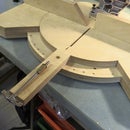Introduction: Drum Sander for Pillar Drill / Drill Press
00:05 I began by checking that the off cut was parallel and worked out the centre.
00:09 I then adjusted the fence on my pillar drill guide table, so when I flip the ply over I find the centre hole. My hole saws are no that deep so I will have to do this when cutting out the discs.
00:29 The ply is 25mm I will use two discs for each drum sander.
00:37 I will be making three different sized drums for now.
00:39 I found a bit of 7mm bar which I cut into three equal sections. This predominantly had no thread on and I will add that later.
01:06 Drill the centre hole of each of the discs to fit with the bar.
01:26 I drilled the bar through the tap, which was a lot quicker than the normal method. Make sure you tighten the chuck really well so it doesn’t slip. I am cutting an M8 thread on a 7mm rod which means I had less resistance than normal.
01:35 I use two part epoxy to glue everything together and tighten it together with nuts.
02:05 I attach each drum to the pillar drill, tightening it well, and using coarse to fine rasps and then sandpaper to filing down the edge. This really depends on how well your hole saws cut. Ideally a lathe would have been a better tool to use for this part but you can at least get the edges square to the bed.
02:49 Mark and drill a small hole about 15mm in from the edge of each drum. The size of this will depend on the bar you will use to fit and pinch the sandpaper. I found a broken drill bit from a mortise which was 4.5mm and I made a 5.5mm hole.
03:08 Cut from the edge downwards towards the hole.
03:33 Cutting the pins for each of the drums.
03:40 Cut sandpaper to fit.
04:00 Hammer in the pins while gripping sandpaper firmly to prevent it slipping.
04:10 Sanding in action.
Off-camera I made a ditch into the pillar drill table to add a sacrificial piece of MDF, some of which have holes cut out to allow the drum to sink a little into the bed. I also realised that the slit creates a little clunking noise and maybe gluing a 2mm strip of rubber around each drum would help grip the sandpaper, further reduce vibration and quieten any noise.
00:09 I then adjusted the fence on my pillar drill guide table, so when I flip the ply over I find the centre hole. My hole saws are no that deep so I will have to do this when cutting out the discs.
00:29 The ply is 25mm I will use two discs for each drum sander.
00:37 I will be making three different sized drums for now.
00:39 I found a bit of 7mm bar which I cut into three equal sections. This predominantly had no thread on and I will add that later.
01:06 Drill the centre hole of each of the discs to fit with the bar.
01:26 I drilled the bar through the tap, which was a lot quicker than the normal method. Make sure you tighten the chuck really well so it doesn’t slip. I am cutting an M8 thread on a 7mm rod which means I had less resistance than normal.
01:35 I use two part epoxy to glue everything together and tighten it together with nuts.
02:05 I attach each drum to the pillar drill, tightening it well, and using coarse to fine rasps and then sandpaper to filing down the edge. This really depends on how well your hole saws cut. Ideally a lathe would have been a better tool to use for this part but you can at least get the edges square to the bed.
02:49 Mark and drill a small hole about 15mm in from the edge of each drum. The size of this will depend on the bar you will use to fit and pinch the sandpaper. I found a broken drill bit from a mortise which was 4.5mm and I made a 5.5mm hole.
03:08 Cut from the edge downwards towards the hole.
03:33 Cutting the pins for each of the drums.
03:40 Cut sandpaper to fit.
04:00 Hammer in the pins while gripping sandpaper firmly to prevent it slipping.
04:10 Sanding in action.
Off-camera I made a ditch into the pillar drill table to add a sacrificial piece of MDF, some of which have holes cut out to allow the drum to sink a little into the bed. I also realised that the slit creates a little clunking noise and maybe gluing a 2mm strip of rubber around each drum would help grip the sandpaper, further reduce vibration and quieten any noise.




